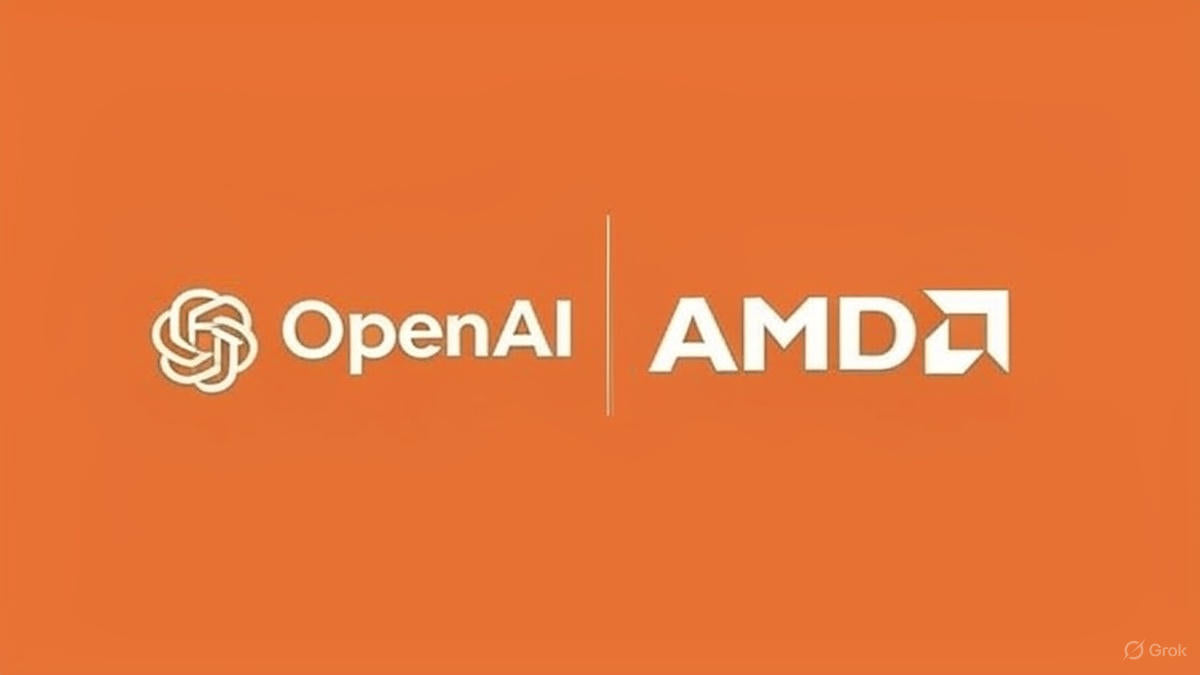OpenAI and AMD Forge Multi-Billion Dollar Partnership to Fuel AI Expansion
On October 6, 2025, OpenAI and Advanced Micro Devices (AMD) announced a landmark multi-billion dollar partnership aimed at accelerating the development of artificial intelligence. This collaboration marks a pivotal moment in the AI hardware sector, with OpenAI committing to purchase up to 6 gigawatts of AMD Instinct GPUs over multiple years. The deal not only challenges Nvidia’s long-standing dominance but also highlights the escalating demand for high-performance computing to power next-generation AI models.
BREAKING: OpenAI and AMD have announced a multibillion-dollar partnership to build AI data centers using AMD’s MI450 chips starting next year.
— amit (@amitisinvesting) October 6, 2025
Details:
- OpenAI committed to purchasing 6 gigawatts of AMD chips, expected to generate tens of billions in revenue for AMD over the… pic.twitter.com/f1ROVy0boT
Key Details of the Partnership
The multi-year agreement positions AMD as OpenAI’s strategic compute partner. Key points include:
- Initial Deployment: 1-gigawatt of AMD Instinct MI450 GPUs starting late 2026.
- Scaling: Gradual deployment to a total of 6 gigawatts, contingent on milestones.
- Financial Structure: OpenAI receives warrants for up to 160 million AMD shares (~10% of the company) at a nominal price of 1 cent per share, vesting based on milestones, stock performance, and technical achievements.
- Existing Collaboration: Builds on prior use of AMD MI300X and MI350X GPUs, reinforcing joint AI innovation.
This arrangement ensures both companies align long-term interests while leveraging AMD’s high-performance computing capabilities for OpenAI’s AI models.
Executive Insights and Strategic Implications
Key executives emphasized the significance:
- Dr. Lisa Su (AMD CEO): Highlights the partnership’s role in enabling massive AI scale and ecosystem advancement.
- Sam Altman (OpenAI CEO): Notes that AMD’s computing power accelerates AI development and broad access to advanced AI tools.
- Greg Brockman (OpenAI President): Stresses deep collaboration across hardware and software for global AI benefit.
- Jean Hu (AMD CFO): Predicts tens of billions in revenue and substantial shareholder value while supporting OpenAI’s infrastructure buildout.
Strategic Takeaways:
- OpenAI diversifies chip suppliers, reducing dependence on Nvidia.
- AMD strengthens its presence in the AI data center market with cost-effective, high-performance alternatives.
Market Reaction and Broader Impact
- Stock Surge: AMD stock exceeded $200, with a 24% pre-market increase.
- Social Media Buzz: Immediate reactions on platform X, with investors expressing excitement and skepticism over funding and projections.
- Industry Implications: The deal signals a new era where AI developers and chipmakers collaborate to meet unprecedented computational demands, reshaping competition and innovation in AI hardware.
Breaking down the AI deals between $NVDA, $AMD & OpenAI pic.twitter.com/oHqD4SsiXL
— Shay Boloor (@StockSavvyShay) October 6, 2025
FAQs
- Q1: What GPUs are included in the OpenAI-AMD deal?
- A1: The partnership starts with AMD Instinct MI450 GPUs, with potential future upgrades to higher-end series.
- Q2: How does this deal affect Nvidia?
- A2: It diversifies OpenAI’s chip supply, potentially reducing reliance on Nvidia’s GPUs and intensifying market competition.
- Q3: What is the financial structure of the partnership?
- A3: OpenAI receives warrants for up to 160 million AMD shares at a nominal price, vesting based on milestones, stock performance, and technical goals.
- Q4: Why is this deal important for AI development?
- A4: It ensures access to massive computing power necessary for training large-scale AI models, accelerating innovation in generative AI and AI services.
Analysis and Long-Form Opinion
The OpenAI-AMD partnership is a defining moment in the evolution of AI infrastructure. It illustrates a fundamental shift: the AI revolution is no longer solely about software breakthroughs; it is increasingly hardware-driven. Access to vast GPU arrays enables the training of expansive generative models, from language to multimodal AI systems, which in turn expands the AI ecosystem’s capabilities.
From a strategic lens, AMD gains market leverage in the data center and AI computing segment, historically dominated by Nvidia. The inclusion of equity-based incentives aligns both firms toward long-term growth, not just short-term financial gains. For OpenAI, this multi-gigawatt deployment ensures that scaling AI models is feasible without bottlenecks in hardware, which is critical given the exponential growth in model sizes and data requirements.
Moreover, this collaboration exemplifies a trend toward vertical integration in AI: software innovators partnering closely with hardware providers to optimize efficiency, performance, and cost. Investors, technologists, and AI enthusiasts must view this not just as a deal, but as a blueprint for future AI infrastructure strategies. The implications extend beyond mere revenue gains—they signal an accelerated timeline for AI’s integration into industries, education, healthcare, and creative sectors globally.
In essence, OpenAI and AMD are setting a precedent: those who control both the compute and software layers are likely to dictate the pace of AI advancement. The partnership highlights that sustainable AI progress depends as much on hardware innovation and strategic collaboration as it does on algorithmic breakthroughs. For the global AI ecosystem, this is a landmark step toward scaling intelligence safely, efficiently, and inclusively.


0 comments